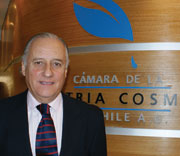The Latin American C&T market is holding strong and is still looking at solid growth, led by its BRIC member Brazil. Cristina Kroll reports
Brazil – boom time
The Brazilian beauty and personal care market is expected to enjoy continued growth this year. João Carlos Basilio, president of the Brazilian toiletry, perfumery and cosmetic association ABIHPEC tells SPC that the local C&T industry is expected to increase 11% to 13% in value during this year. At the same time, Basilio points out that the positive figures are driven by the growth in workers’ incomes and employment.
“The Brazilian market closed 2009 with US$29bn in sales and a total unit volume of 1.65bn tonnes,” says ABIHPEC. The C&T industry in Brazil represents 1.3% of local GDP and according to Basilio: “ABIHPEC is working hard to achieve an equilibrium in the sector. We are a bit far of the objectives, but we think we can put in a good performance to reach our aims by 2020.”

João Carlos Basilio, president, ABIHPEC
At the same time, a report by Euromonitor underlines that parapharmacies/drugstores, and in particular, direct selling companies - represented by leading players such as Natura Cosmeticos and Avon Brazil - have experienced growth rates above the average. “An increasing number of sales representatives, high-tech new products and heavy advertising campaigns represent the main factors contributing to the positive performances achieved by those companies,” the report points out. “In addition, parapharmacies/drugstores should increase participation over the forecast period as a consequence of The National Health Surveillance Agency’s (ANVISA) resolution moving all OTC products behind the counter and leading to shelf space availability, which will ultimately benefit beauty and personal care items and therapeutically positioned/pharma brands.”
Euromonitor also underlines that Brazil is continuing to gain ground as a regional centre for the Latin American beauty and personal care industry. Of the top ten companies in the Brazilian beauty and personal care market, two are local companies with presence in other countries in the region and five multinational players have Brazil as a regional centre. Major ingredient companies servicing this industry also have regional hubs for Latin America in Brazil. According to the same report, sun care, baby care, depilatories and colour cosmetics are all expected to see dynamic value growth in coming years, driven by greater consumption in terms of purchase frequency, higher penetration in some lower income groups and better distribution”.
Columbia – recovery position
The growth characteristics of the Colombian cosmetics industry in 2010 show a good level of recouperation, with 4.4% growth during the first quarter. “We hope to stay this way for the whole year, and we’ve seen indicators that it will stay that way,” Jaime Concha Prada, executive director of the Colombian Chamber of Cosmetics and Toiletries Industry tells SPC. “Traditionally, the cosmetics industry in Colombia has grown on average at double the rate of the manufacturing industry for the last ten years, by what is projected to be growth of around 10%. In 2006, retail prices in the local cosmetic market, which represent around 4% of Colombian GDP, closed at $3.05bn, in fourth place behind Brazil, Mexico, and Venezuela. If not for the speculation of the dollar in Venezuela, Colombia would have obtained third place.”
Mexico – catch-up challenge
Another relevant market is Mexico. According to Giselle Ramos, pr manager for the National Chamber of the Perfumery, Cosmetics and Toiletries Industry of Mexico (CANIPEC), “the national cosmetic market is consolidating as a strategic sector”. Mexico, which is the third most important country in the continent, behind the US and Brazil, anticipates growth of 5% in the C&T sector in 2010.
In terms of the size of the units and billing of the C&T sector, Ramos says: “During 2009 there was growth of around 3% while the average for the last ten years has been 5%. The value of the market is estimated to be $7bn per year in sales.”

Ariel Saiz, secretary of the cosmetics chamber, Uruguay
Mexican cosmetics exports in 2009 grew 13% on the previous year and imports 2%, giving a positive balance of 37%. In terms of GDP, Ramos says the cosmetics industry represents approximately 8% and the industrial GDP represents 4.6%.
Looking ahead to challenges facing the Mexican C&T industry in the coming year, Ramos underlines that “despite the possibility of further growth, in comparison to other Latin American countries such as Brazil, Colombia, Argentina and Chile, countries that are showing growth in the double digits, Mexico is in fact behind, and catching up will be a great challenge”.
Uruguay – high ideals
In Uruguay, the characteristics and perspectives of growth in the cosmetics industry are reflected in the first quarter of 2010, which started with growth of 6-7% compared to the start of the second quarter, which started more slowly. 
Álvara Márquez, vp Chilean Chamber of Cosmetic Commerce
According to Ariel Saiz, secretary of the cosmetics chamber, if greater growth in the cosmetics sector is to be seen it will be among top brands. At retail value, Saiz estimates Uruguay´s C&T market at around $240m.Chile – positive outlook
Chile’s C&T industry has shown an increase. In the first quarter it demonstrated a 9.5% growth rate and the second semester is projected to be fairly positive, with annual growth estimated at around 8% or 9%. GDP for the country will be 4.5% to 5% with an inflation that should not exceed 3.5% before the end of the year.
“Despite the effects of the tragic earthquake on 27 February this year, Chile has experienced an increase in consumption. Various cosmetic companies suffered a great deal of damage, but the market has recovered rapidly, and other than sales in the month of March, not much else was affected”, says Álvaro Márquez, vice president of the Chilean Chamber of Cosmetic Industry.
| Table 1: Latin America top 10 C&T brands, RSP (2009) | |
| Brand | Company |
| Avon | Avon Products Inc |
| Natura | Natura Cosméticos SA |
| Colgate | Colgate-Palmolive Co |
| Gillette | Procter & Gamble Co, The |
| O Boticário | Botica Comercial Farmacêutica Ltda |
| Sunsilk | Unilever Group |
| L’Oréal Paris | L’Oréal Groupe |
| Nivea | Beiersdorf AG |
| Palmolive | Colgate-Palmolive Co |
| Dove | Unilever Group |
| Source: Euromonitor International | |
Acquisitions & partnerships
One of the greatest operations in the region has been the selling of Argentine hair colour manufacturer Issue Group to Indian company Godrej Consumer Products (GCPL) in June 2010 for an undisclosed amount. The Indian company now owns 100% of the Issue Group, which comprises Cuenca Laboratories, Consell, Issue Uruguay and Issue Brazil, which had a leading position in the Argentine hair colour market with a market share in excess of 20% and revenues of over $33m in 2009. The acquisition of the Issue Group is part of the company’s plan to have presence in three continents – Asia, Africa and Latin America – according to a representative from GCPL. The new president of the company will be Adi Grodej, current president of GCPL, while the vp will be Antonio Cao, current ceo of Issue Group. Argentina’s C&T market was up 20.6% in 2009 to $2948.1m, according to Euromonitor.
“Following its acquisition of the hair colour company, India’s Godrej Consumer Products Ltd has further extended its business in Latin America through agreement of the acquisition of a 100% stake in Argencos, Argentina’s largest hairspray company,” says Roberto Hlace, president of Issue Group. “The two companies provide us with a tremendous platform for establishing a strong presence in the fast growing hair colour markets in Latin America.”
In February this year, California-based Jafra Cosmetics International announced the opening of a new manufacturing facility in Mexico as a result of rising consumer demand for its products. The direct selling company, a subsidiary of Vorwerk and Co, will employ 800 people at the $30m state-of-the-art factory. The 23-acre complex in Querétaro, Mexico, is now Jafra’s lead manufacturing plant as it is 50% larger than the company’s previous plant and can produce up to 200 million units annually, according to the company. The construction of the factory forms part of Jafra’s expansion strategy and allows it to increase production to deal with current demand as well as presenting an opportunity to expand at a later date. According to Jafra, the Querétaro plant will serve as a central location for supply chain activities and as a centralised activity for the global supply of products.
| Table 2: Top 5 C&T brands, RSP (2009) | |
| Brand | Company |
| Argentina | |
| Avon | Avon Products Inc |
| Sunsilk | Unilever Group |
| Rexona | Unilever Group |
| L’Oréal Paris | L’Oréal Groupe |
| Dove | Unilever Group |
| Brazil | |
| Natura | Natura Cosméticos SA |
| Avon | Avon Products Inc |
| L’Oréal Paris | L’Oréal Groupe |
| O Boticário | Botica Comercial Farmacêutica Ltda |
| Gillette | Procter & Gamble Co, The |
| Sunsilk | Unilever Group |
| Chile | |
| Avon | Avon Products Inc |
| L’Oréal Paris | L’Oréal Groupe |
| Nivea | Beiersdorf AG |
| Gillette | Procter & Gamble Co, The |
| Signal | Unilever Group |
| Sunsilk | Unilever Group |
| Columbia | |
| Avon | Avon Products Inc |
| Colgate | Colgate-Palmolive Co |
| Esika | Corporación Belcorp |
| Gillette | Procter & Gamble Co, The |
| Yanbal | Unique-Yanbal Group |
| Mexico | |
| Avon | Avon Products Inc |
| Jafra | Vorwerk & Co KG |
| Colgate | Colgate-Palmolive Co |
| Fuller | Tupperware Brands Corp |
| L’Oréal Paris | L’Oréal Groupe |
| Uruguay | |
| Colgate | Colgate-Palmolive Co |
| Avon | Avon Products Inc |
| Sunsilk | Unilever Group |
| Nuvó | Tupperware Brands Corp |
| Pantene | Procter & Gamble Co, The |
| Source: Euromonitor International | |
Mexico is proving to be a popular location for the cosmetics industry. Cosmetics packaging supplier HCP Packaging announced plans to inaugurate a production facility in Mexico back in 2009. Like Topline, HCP cited reduced cost and lead times as the main reasons for the venture, highlighting the convenience of increased proximity to its customers’ filling operations.
The US firm HallStar Company has announced plans to form a new joint venture in Brazil with Brazilian polymeric and monomeric compound specialist Scandiflex. The new joint venture, HallStar do Brazil will market the US company’s wide range of personal care ingredients and will be based in Sao Paulo. “Brazil is one of the fastest growing personal care markets in the world and we are very excited to bring our ingredients to Brazilian formulators and ultimately to Brazilian consumers,” says Hallstar ceo, John Paro.
Speciality chemicals supplier Cognis has opened an SO3 sulfation plant at its site in Ecatepec, Mexico. The new facility will better equip the company to deal with technologies including sulfation and ethoxylation in close proximity to major customers. According to the company, ingredients produced at the unit such as alcohol sulfates, fatty alcohol ether sulfates and other surfactants will be of significantly higher quality as the new reactor uses crystalline sulphur instead of chlorosulfonic acid as the basis for the sulfation process. This results in purer products containing no chlorine by-products.
French supplier Greentech has set up a new factory in Tarapoto in northern Peru. The plant’s jungle location is closer to Greentech’s Inca inchi crops, which the company hopes will help it meet growing demand for its certified organic Inca inchi oil. Greentech also says the new plant’s proximity will enable the production of new cosmetic actives extracted from Inca inchi seed cakes. Greentech’s activities in Peru include its Omega Project, set up in collaboration with Peruvian company Agroindustrias Amazonicas in 2003, which has contributed to the economic development of producers from local villages around the plant.
Rules & regulations
In terms of regulation, Colombia has shown important advances. According to Concha Prada: “The validity certificates have increased, microbiological standards are being arranged, as well as the requirements of the natural ingredients to be used in cosmetics in the Andean region, the norms of use and taking advantage of the natural Colombian biodiversity, the norms for warnings on cosmetic labels, inspection guides and protection of cosmetic plants.”
In Mexico, one of the latest projects is the Advertisement Auto regulation code for cosmetic products. “This document will permit the development of ad activity driven by the consumer through mass media based on ethical principles, favouring the knowledge and comprehension of the benefits, scope and correct use of cosmetic products,” according to Ramos. With this Code “the consumer can be certain that the products they consume are secure and that the ads directed at them are honest, legal, truthful and ascertainable”.
And a relevant advance in the regulation field in Uruguay is the elimination of the internal tax (IMESI) of 11.5% in sun protection products. “The next challenge for the Uruguayan Cosmetic Chamber will be to eliminate IMESI from other cosmetic products in the country, as has already been done in Brazil and Argentina,” explains Saiz.

A positive growth in the income of workers and employment in Brazil is helping boost sales of cosmetics and personal care products
On the other hand, Chile’s Márquez adds: “The industry will solicit the authorities for some form of control for cosmetic products. These should be serious controls, not bureaucratic ones that assist the increase of technical obstacles of commerce and that keep a firm hand on the incredible increase of contraband and fake products that invade the country every day, especially from China.
“Only regulations for sun protection (SPF 50 plus), baby products, hyperallergenic products and fluoride toothpastes have been modified to-date. The new regimen will face many commercial obstacles, both in the country and in the region in terms of imports and exports and the innumerable barriers due to the large number of free trade agreements that our country has around the world.
“We are seeing challenges for the region. With CASIC (Council Association for the Latin American Cosmetics Industry) we are confronted with sanitary regulation, technical obstacles to commerce, contraband, fakes and parallel markets. We are attending to the development and advances in natural and organic products, environmental themes, social responsibility and an increase in commerce between countries in the region,” Márquez concludes.


